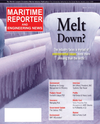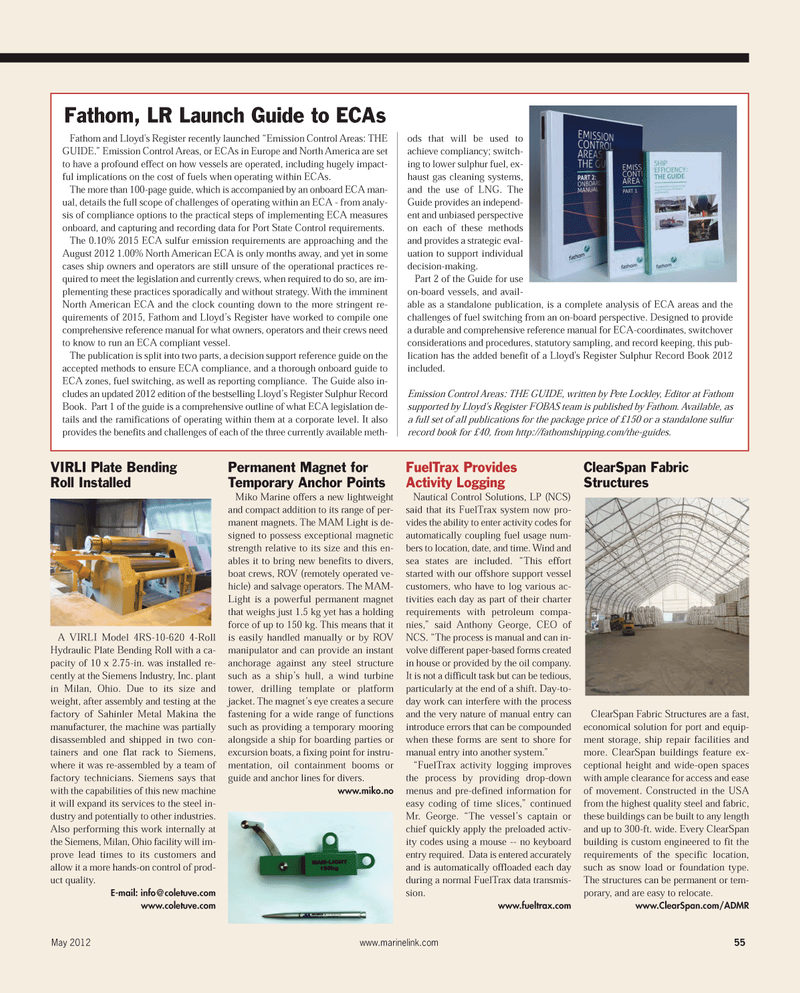
Page 55: of Maritime Reporter Magazine (May 2012)
The Green Ship Edition
Read this page in Pdf, Flash or Html5 edition of May 2012 Maritime Reporter Magazine
May 2012www.marinelink.com 55VIRLI Plate Bending Roll InstalledA VIRLI Model 4RS-10-620 4-Roll Hydraulic Plate Bending Roll with a ca-pacity of 10 x 2.75-in. was installed re- cently at the Siemens Industry, Inc. plant in Milan, Ohio. Due to its size andweight, after assembly and testing at thefactory of Sahinler Metal Makina the manufacturer, the machine was partially disassembled and shipped in two con- tainers and one flat rack to Siemens,where it was re-assembled by a team of factory technicians. Siemens says that with the capabilities of this new machine it will expand its services to the steel in- dustry and potentially to other industries.Also performing this work internally at the Siemens, Milan, Ohio facility will im- prove lead times to its customers and allow it a more hands-on control of prod- uct quality. E-mail: [email protected] Permanent Magnet forTemporary Anchor Points Miko Marine offers a new lightweight and compact addition to its range of per- manent magnets. The MAM Light is de- signed to possess exceptional magnetic strength relative to its size and this en- ables it to bring new benefits to divers, boat crews, ROV (remotely operated ve- hicle) and salvage operators. The MAM- Light is a powerful permanent magnet that weighs just 1.5 kg yet has a holdingforce of up to 150 kg. This means that it is easily handled manually or by ROV manipulator and can provide an instant anchorage against any steel structure such as a ship?s hull, a wind turbine tower, drilling template or platform jacket. The magnet?s eye creates a secure fastening for a wide range of functions such as providing a temporary mooring alongside a ship for boarding parties orexcursion boats, a fixing point for instru- mentation, oil containment booms orguide and anchor lines for divers. www.miko.no FuelTrax Provides Activity LoggingNautical Control Solutions, LP (NCS)said that its FuelTrax system now pro- vides the ability to enter activity codes for automatically coupling fuel usage num-bers to location, date, and time. Wind and sea states are included. ?This effort started with our offshore support vessel customers, who have to log various ac- tivities each day as part of their charter requirements with petroleum compa-nies,? said Anthony George, CEO of NCS. ?The process is manual and can in-volve different paper-based forms created in house or provided by the oil company. It is not a difficult task but can be tedious, particularly at the end of a shift. Day-to-day work can interfere with the process and the very nature of manual entry can introduce errors that can be compoundedwhen these forms are sent to shore formanual entry into another system.? ?FuelTrax activity logging improves the process by providing drop-down menus and pre-defined information for easy coding of time slices,? continued Mr. George. ?The vessel?s captain or chief quickly apply the preloaded activ- ity codes using a mouse -- no keyboard entry required. Data is entered accuratelyand is automatically offloaded each day during a normal FuelTrax data transmis- sion. www.fueltrax.com ClearSpan Fabric Structures ClearSpan Fabric Structures are a fast, economical solution for port and equip-ment storage, ship repair facilities and more. ClearSpan buildings feature ex- ceptional height and wide-open spaceswith ample clearance for access and easeof movement. Constructed in the USA from the highest quality steel and fabric, these buildings can be built to any length and up to 300-ft. wide. Every ClearSpan building is custom engineered to fit the requirements of the specific location, such as snow load or foundation type. The structures can be permanent or tem-porary, and are easy to relocate. www.ClearSpan.com/ADMR Fathom and Lloyd's Register recently launched ?Emission Control Areas: THE GUIDE.? Emission Control Areas, or ECAs in Europe and North America are set to have a profound effect on how vessels are operated, including hugely impact- ful implications on the cost of fuels when operating within ECAs. The more than 100-page guide, which is accompanied by an onboard ECA man-ual, details the full scope of challenges of operating within an ECA - from analy-sis of compliance options to the practical steps of implementing ECA measuresonboard, and capturing and recording data for Port State Control requirements. The 0.10% 2015 ECA sulfur emission requirements are approaching and theAugust 2012 1.00% North American ECA is only months away, and yet in some cases ship owners and operators are still unsure of the operational practices re- quired to meet the legislation and currently crews, when required to do so, are im- plementing these practices sporadically and without strategy. With the imminent North American ECA and the clock counting down to the more stringent re- quirements of 2015, Fathom and Lloyd?s Register have worked to compile one comprehensive reference manual for what owners, operators and their crews need to know to run an ECA compliant vessel. The publication is split into two parts, a decision support reference guide on the accepted methods to ensure ECA compliance, and a thorough onboard guide toECA zones, fuel switching, as well as reporting compliance. The Guide also in- cludes an updated 2012 edition of the bestselling Lloyd?s Register Sulphur Record Book. Part 1 of the guide is a comprehensive outline of what ECA legislation de- tails and the ramifications of operating within them at a corporate level. It also provides the benefits and challenges of each of the three currently available meth- ods that will be used toachieve compliancy; switch- ing to lower sulphur fuel, ex- haust gas cleaning systems, and the use of LNG. The Guide provides an independ- ent and unbiased perspective on each of these methodsand provides a strategic eval- uation to support individual decision-making. Part 2 of the Guide for use on-board vessels, and avail- able as a standalone publication, is a complete analysis of ECA areas and thechallenges of fuel switching from an on-board perspective. Designed to provide a durable and comprehensive reference manual for ECA-coordinates, switchover considerations and procedures, statutory sampling, and record keeping, this pub- lication has the added benefit of a Lloyd's Register Sulphur Record Book 2012 included. Emission Control Areas: THE GUIDE, written by Pete Lockley, Editor at Fathom supported by Lloyd's Register FOBAS team is published by Fathom. Available, as a full set of all publications for the package price of £150 or a standalone sulfur record book for £40, from http://fathomshipping.com/the-guides. Fathom, LR Launch Guide to ECAsMR May 12 # 7 (50-55):MR Template 5/7/2012 3:18 PM Page 55

 54
54

 56
56
